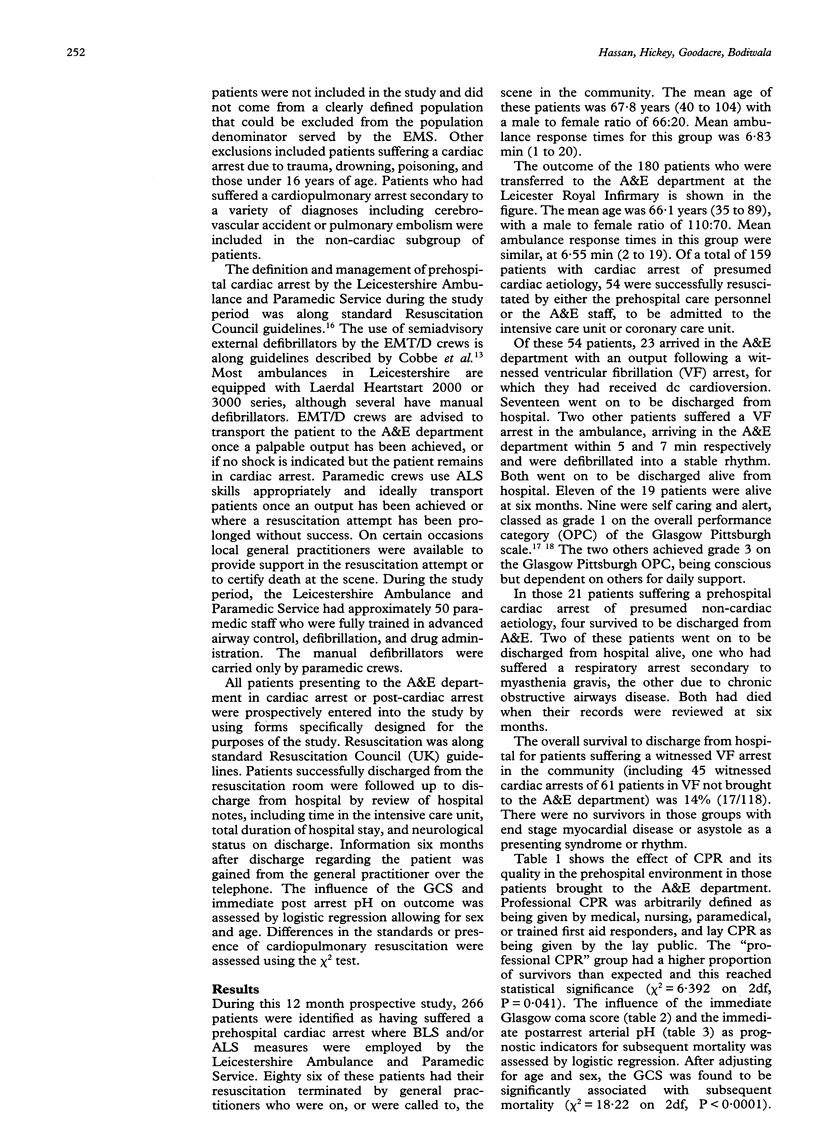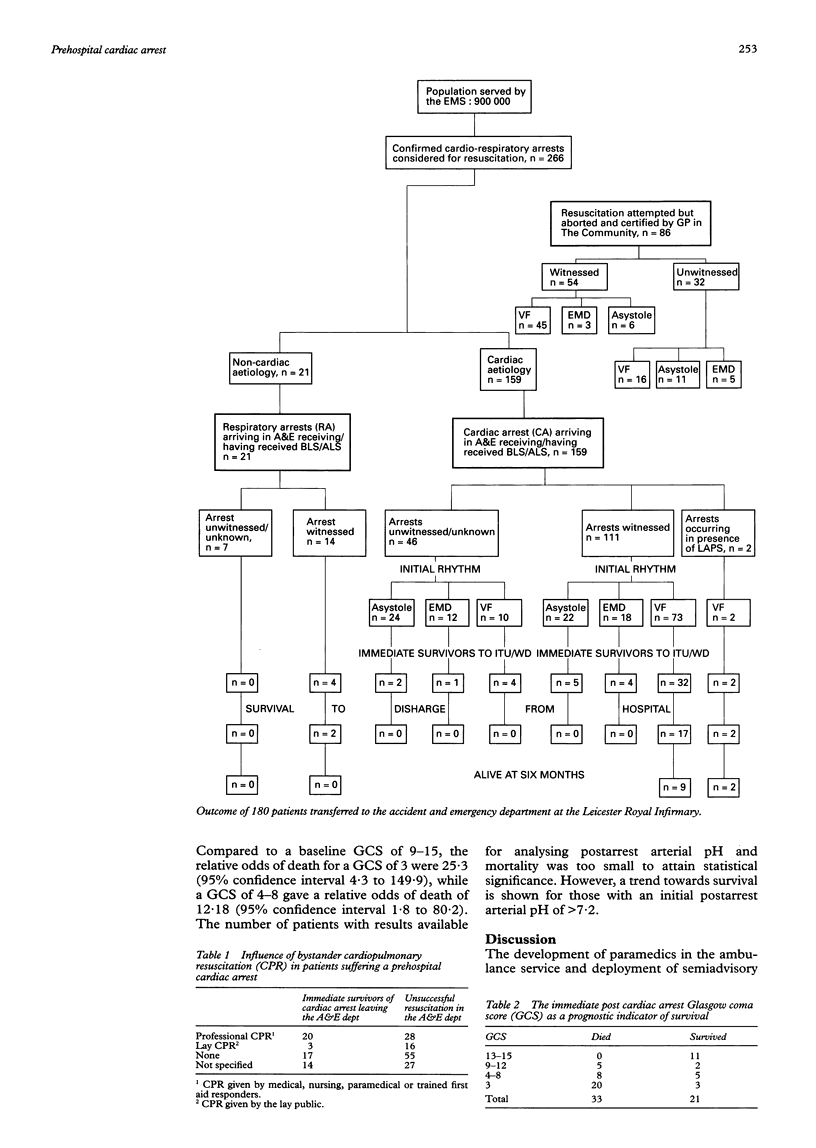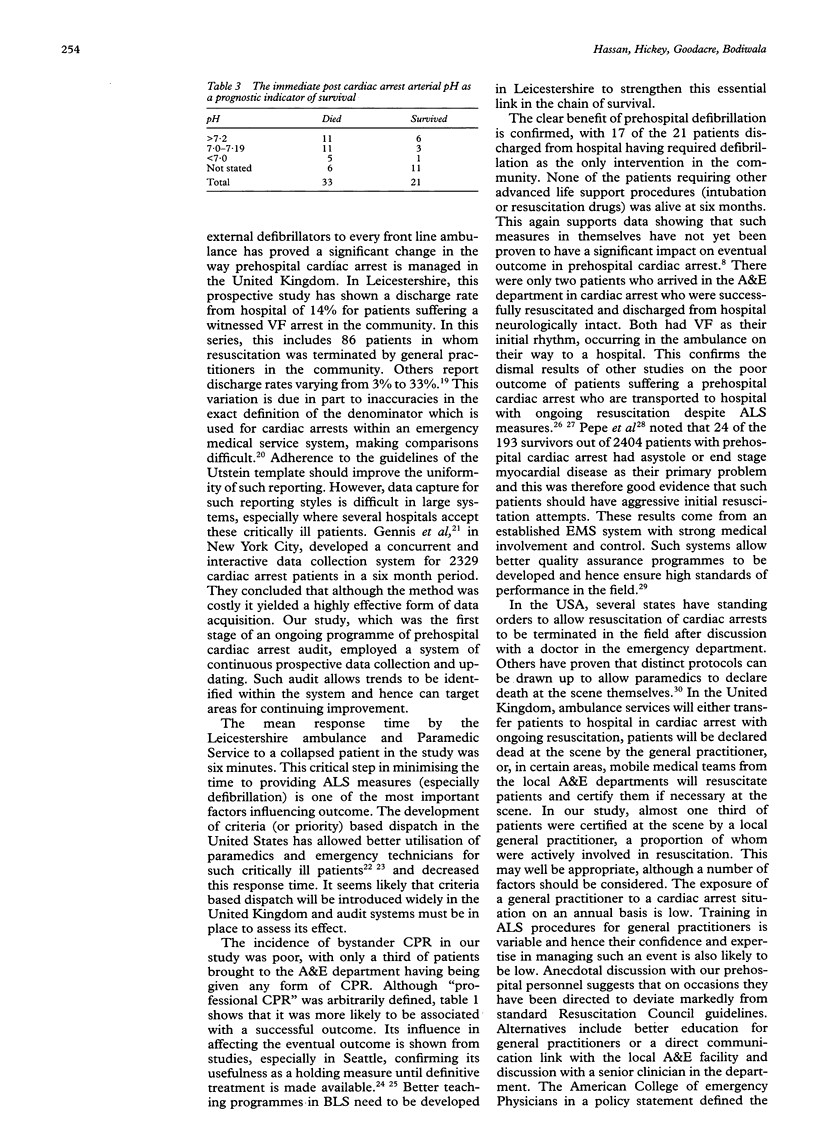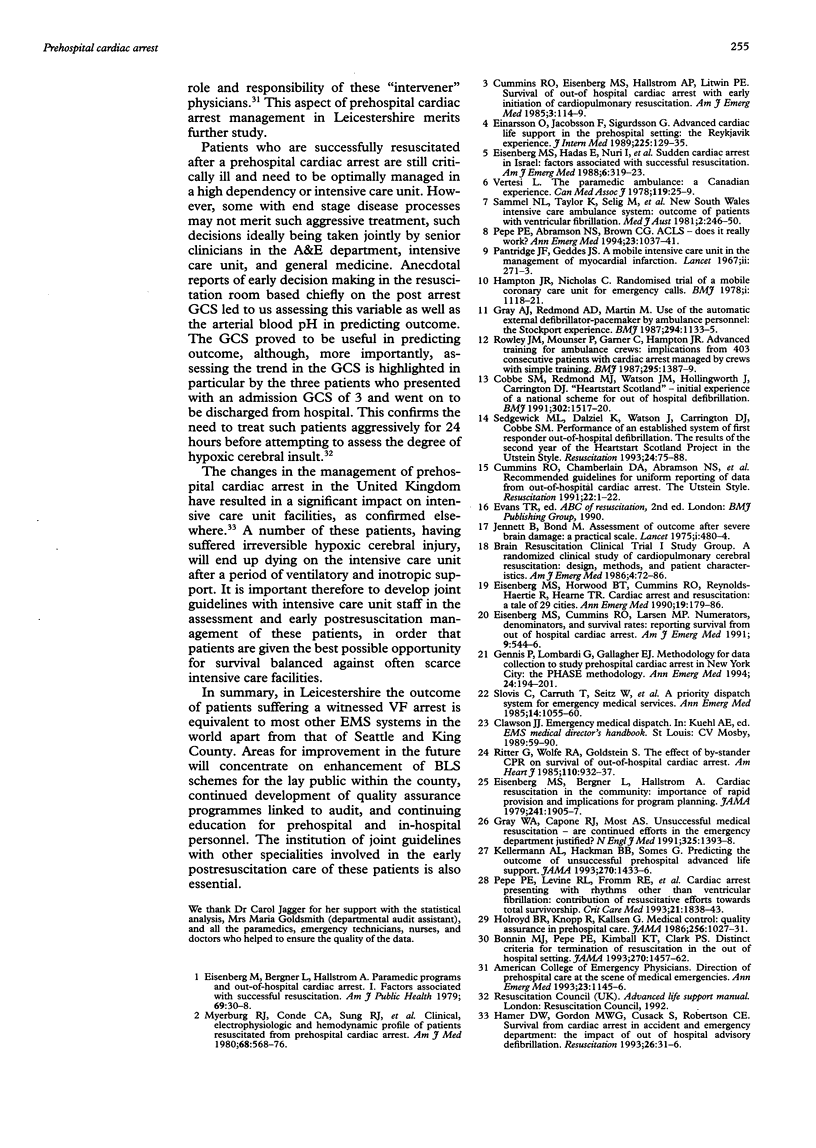Abstract
OBJECTIVE: To identify the impact of advanced life support skills on outcome for prehospital cardiac arrest in a defined population and to assess the value of certain physiological variables in predicting the outcome in those successfully resuscitated in the accident and emergency (A&E) department; to identify areas for improvement in the outcome of such patients. DESIGN: Prospective 12 month study. SETTING: Leicestershire, United Kingdom. MAIN OUTCOME MEASURE: Survival to hospital discharge and status at 6 months. RESULTS: 266 patients were identified as having suffered a prehospital cardiac arrest; of these, 86 had their resuscitation attempt terminated in the community by a general practitioner and 180 were transferred to the A&E department of the Leicester Royal Infirmary. Of the latter, 159 were felt to be of cardiac aetiology, and 19 were eventually discharged from hospital. All survivors had experienced a witnessed cardiac arrest, ventricular fibrillation (VF) being identified as the initial rhythm. After adjusting for age and sex using logistic regression, the Glasgow coma score (GCS) was found to be associated with subsequent mortality (chi 2 = 18.22 on 2 df, P < 0.0001). Compared to a baseline GCS of 9-15, the relative odds of death for a GCS of 3 were 25.3 (95% confidence interval 4.3 to 149-9), while a GCS of 4-8 gave a relative odds of death of 12-18 (95% CI 1.8 to 80.2). No significant association was found between postarrest arterial pH and mortality. CONCLUSIONS: The immediate GCS on admission is a predictor of outcome and it is important to monitor its trend in the first 24 h. Multidisciplinary audit and joint guidelines with other specialties are important in optimising the care of these patients.
Full text
PDF




Selected References
These references are in PubMed. This may not be the complete list of references from this article.
- Bonnin M. J., Pepe P. E., Kimball K. T., Clark P. S., Jr Distinct criteria for termination of resuscitation in the out-of-hospital setting. JAMA. 1993 Sep 22;270(12):1457–1462. [PubMed] [Google Scholar]
- Cummins R. O., Eisenberg M. S., Hallstrom A. P., Litwin P. E. Survival of out-of-hospital cardiac arrest with early initiation of cardiopulmonary resuscitation. Am J Emerg Med. 1985 Mar;3(2):114–119. doi: 10.1016/0735-6757(85)90032-4. [DOI] [PubMed] [Google Scholar]
- Einarsson O., Jakobsson F., Sigurdsson G. Advanced cardiac life support in the prehospital setting: the Reykjavik experience. J Intern Med. 1989 Feb;225(2):129–135. doi: 10.1111/j.1365-2796.1989.tb00052.x. [DOI] [PubMed] [Google Scholar]
- Eisenberg M. S., Bergner L., Hallstrom A. Cardiac resuscitation in the community. Importance of rapid provision and implications for program planning. JAMA. 1979 May 4;241(18):1905–1907. doi: 10.1001/jama.241.18.1905. [DOI] [PubMed] [Google Scholar]
- Eisenberg M. S., Cummins R. O., Larsen M. P. Numerators, denominators, and survival rates: reporting survival from out-of-hospital cardiac arrest. Am J Emerg Med. 1991 Nov;9(6):544–546. doi: 10.1016/0735-6757(91)90108-v. [DOI] [PubMed] [Google Scholar]
- Eisenberg M. S., Hadas E., Nuri I., Applebaum D., Roth A., Litwin P. E., Hallstrom A., Nagel E. Sudden cardiac arrest in Israel: factors associated with successful resuscitation. Am J Emerg Med. 1988 Jul;6(4):319–323. doi: 10.1016/0735-6757(88)90146-5. [DOI] [PubMed] [Google Scholar]
- Eisenberg M. S., Horwood B. T., Cummins R. O., Reynolds-Haertle R., Hearne T. R. Cardiac arrest and resuscitation: a tale of 29 cities. Ann Emerg Med. 1990 Feb;19(2):179–186. doi: 10.1016/s0196-0644(05)81805-0. [DOI] [PubMed] [Google Scholar]
- Eisenberg M., Bergner L., Hallstrom A. Paramedic programs and out-of-hospital cardiac arrest: I. Factors associated with successful resuscitation. Am J Public Health. 1979 Jan;69(1):30–38. doi: 10.2105/ajph.69.1.30. [DOI] [PMC free article] [PubMed] [Google Scholar]
- Gennis P., Lombardi G., Gallagher E. J. Methodology for data collection to study prehospital cardiac arrest in New York City: the PHASE methodology. PreHospital Arrest Survival Evaluation Group. Ann Emerg Med. 1994 Aug;24(2):194–201. doi: 10.1016/s0196-0644(94)70130-x. [DOI] [PubMed] [Google Scholar]
- Gray A. J., Redmond A. D., Martin M. A. Use of the automatic external defibrillator-pacemaker by ambulance personnel: the Stockport experience. Br Med J (Clin Res Ed) 1987 May 2;294(6580):1133–1135. doi: 10.1136/bmj.294.6580.1133. [DOI] [PMC free article] [PubMed] [Google Scholar]
- Gray W. A., Capone R. J., Most A. S. Unsuccessful emergency medical resuscitation--are continued efforts in the emergency department justified? N Engl J Med. 1991 Nov 14;325(20):1393–1398. doi: 10.1056/NEJM199111143252001. [DOI] [PubMed] [Google Scholar]
- Hampton J. R., Nicholas C. Randomised trial of a mobile coronary care unit for emergency calls. Br Med J. 1978 Apr 29;1(6120):1118–1121. doi: 10.1136/bmj.1.6120.1118. [DOI] [PMC free article] [PubMed] [Google Scholar]
- Holroyd B. R., Knopp R., Kallsen G. Medical control. Quality assurance in prehospital care. JAMA. 1986 Aug 22;256(8):1027–1031. doi: 10.1001/jama.256.8.1027. [DOI] [PubMed] [Google Scholar]
- Jennett B., Bond M. Assessment of outcome after severe brain damage. Lancet. 1975 Mar 1;1(7905):480–484. doi: 10.1016/s0140-6736(75)92830-5. [DOI] [PubMed] [Google Scholar]
- Kellermann A. L., Hackman B. B., Somes G. Predicting the outcome of unsuccessful prehospital advanced cardiac life support. JAMA. 1993 Sep 22;270(12):1433–1436. [PubMed] [Google Scholar]
- Pantridge J. F., Geddes J. S. A mobile intensive-care unit in the management of myocardial infarction. Lancet. 1967 Aug 5;2(7510):271–273. doi: 10.1016/s0140-6736(67)90110-9. [DOI] [PubMed] [Google Scholar]
- Pepe P. E., Abramson N. S., Brown C. G. ACLS--does it really work? Ann Emerg Med. 1994 May;23(5):1037–1041. doi: 10.1016/s0196-0644(94)70100-8. [DOI] [PubMed] [Google Scholar]
- Pepe P. E., Levine R. L., Fromm R. E., Jr, Curka P. A., Clark P. S., Zachariah B. S. Cardiac arrest presenting with rhythms other than ventricular fibrillation: contribution of resuscitative efforts toward total survivorship. Crit Care Med. 1993 Dec;21(12):1838–1843. doi: 10.1097/00003246-199312000-00009. [DOI] [PubMed] [Google Scholar]
- Ritter G., Wolfe R. A., Goldstein S., Landis J. R., Vasu C. M., Acheson A., Leighton R., Medendrop S. V. The effect of bystander CPR on survival of out-of-hospital cardiac arrest victims. Am Heart J. 1985 Nov;110(5):932–937. doi: 10.1016/0002-8703(85)90187-5. [DOI] [PubMed] [Google Scholar]
- Rowley J. M., Mounser P., Garner C., Hampton J. R. Advanced training for ambulance crews: implications from 403 consecutive patients with cardiac arrest managed by crews with simple training. Br Med J (Clin Res Ed) 1987 Nov 28;295(6610):1387–1389. doi: 10.1136/bmj.295.6610.1387. [DOI] [PMC free article] [PubMed] [Google Scholar]
- Sedgwick M. L., Dalziel K., Watson J., Carrington D. J., Cobbe S. M. Performance of an established system of first responder out-of-hospital defibrillation. The results of the second year of the Heartstart Scotland Project in the 'Utstein Style'. Resuscitation. 1993 Aug;26(1):75–88. doi: 10.1016/0300-9572(93)90166-n. [DOI] [PubMed] [Google Scholar]
- Slovis C. M., Carruth T. B., Seitz W. J., Thomas C. M., Elsea W. R. A priority dispatch system for emergency medical services. Ann Emerg Med. 1985 Nov;14(11):1055–1060. doi: 10.1016/s0196-0644(85)80919-7. [DOI] [PubMed] [Google Scholar]
- Vertesi L. The paramedic ambulance: a Canadian experience. Can Med Assoc J. 1978 Jul 8;119(1):25–29. [PMC free article] [PubMed] [Google Scholar]


